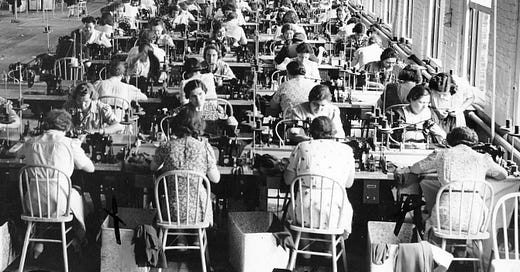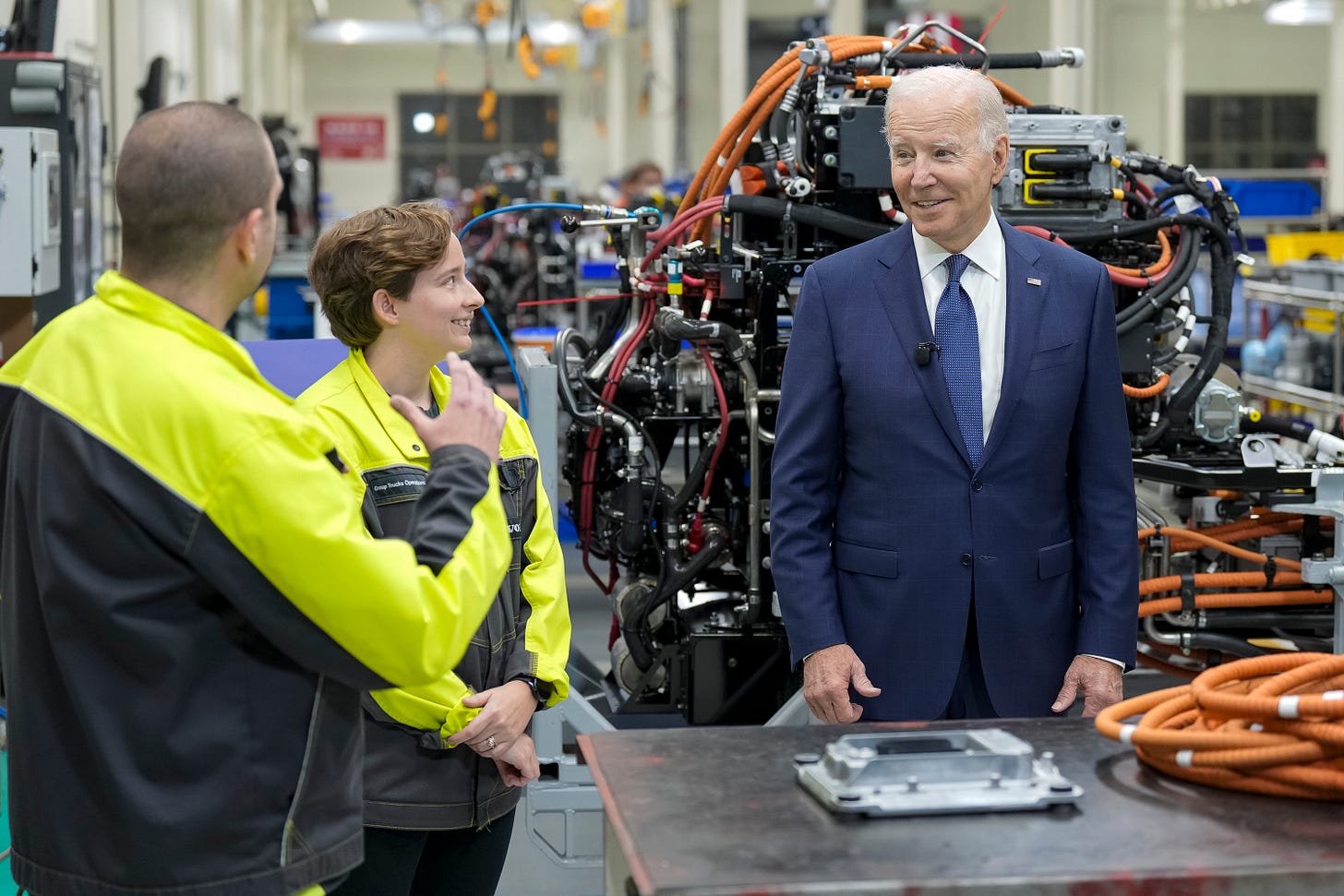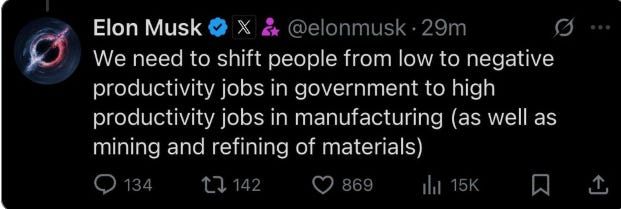Trump and Musk's Manufacturing Bait and Switch
A well-paid, empowered workforce is the last thing they want. How'd you like a job making shirtwaists?
Thank you for reading The Cross Section. This site has no paywall, so I depend on the generosity of readers to sustain the work I present here. If you find what you read valuable and would like it to continue, consider becoming a paid subscriber.
Donald Trump’s disastrous tariff policy has critics across the political spectrum, but one thing most of them agree on is that one of its ostensible goals — to reverse the long decline of American manufacturing — is a good one. Trump’s tariffs will almost certainly fail to bring back the factory jobs that departed over the last few decades, but it would be nice if they did, or if that reindustrialization happened in some other way.
But there’s something much darker and more sinister at work in the way Trump — along with Elon Musk and the tech oligarchs he represents — are attempting to transform the American economy. They would like us to believe they’re working to restore something like the labor situation of the 1950s and 1960s, when a man could walk out of high school and into a factory job with good wages and benefits, one that assured him and his family of a secure middle-class life. But that’s not at all what they have in mind.
They are not trying to turn back the clock. In fact, the kind of economy we had in the middle of the 20th century (at least for white men) is the last thing they want. They’re out to create something much worse.
“We don’t make stuff anymore!”
Let’s start by understanding the supposed problem: We don’t make stuff anymore! You’ve heard it a thousand times, but is it true? The simple answer is no; we make lots of stuff. There are arguments for why we should make more stuff, but we do make lots of stuff. Here’s a graph of industrial output over the last century:
Two important things have changed in the last few decades: what we make, and how many people are involved in making it. A lot of relatively low-wage, low-tech manufacturing has moved overseas, chasing cheap labor. That was devastating to many communities that lost major employers, but the only way those industries could return is if American consumers were willing to pay drastically higher prices for basic consumer goods.
At the same time, advances in technology and productivity have meant that fewer and fewer workers are required in many manufacturing settings. Both those factors contributed to the decline in US manufacturing employment over the last 45 years, but particularly the last 25:
Now ask yourself: When you hear the words “factory job,” what comes to mind? Is it something like an auto plant, where skilled workers perform precise and complicated tasks to create modern products, for which they are paid well and have pride in their work? That’s certainly the kind of factory that the Biden administration wanted more of, which is why they designed and implemented a detailed industrial policy meant to boost high-tech US manufacturing. And to a degree, it worked; investment in manufacturing rose dramatically during his term.
Biden was certainly sincere in his desire to create a manufacturing renaissance, but he was also both reinforcing and playing to that romantic idea of the 1950s factory. Here’s the part that isn’t discussed enough: Those jobs back then weren’t secure and well-paid because of something inherent to manufacturing. They were secure and well-paid because those workers belonged to unions. The unions fought for those wages and benefits and made those jobs what they were. Then capital fought back, with the help of Republican politicians, and today organized labor is a shadow of what it once was.
In the last few days, people on the internet have been pointing out that workers in McDonald’s in Denmark make about $22 an hour, while an auto worker in Alabama makes as little as $14 an hour. Paul Krugman boils down the lesson of this factoid:
What this comparison tells us is that institutions that empower workers are more important in determining workers’ pay than what sector they work in. Two-thirds of Danish workers are represented by unions, while auto workers in Alabama aren’t unionized. Empowering service sector workers can make their jobs good; disempowering manufacturing workers can make their jobs bad.
Perhaps you can argue that there’s something inherently ennobling in the act of creation that makes a $14/hour job at a car factory more satisfying than a $14/hour job at a supermarket. But the truth is that for the vast majority of people, what makes the difference is who they work with, whether their boss is a jerk, how they’re treated, whether the job allows them any measure of autonomy — in other words, one can be happy in a retail job and miserable in a manufacturing job. The 143 workers who died in the Triangle Shirtwaist Factory fire a century ago had manufacturing jobs, but theirs was not a happy lot.
What Republicans are really after
Which brings us back to Trump, Musk, and the rest of this administration. They have been quite explicit in their hope that the hundreds of thousands of workers being purged from the federal government can be sent to do more “productive” work in factories and mines, as Musk recently tweeted:
“We are shedding excess labor in the federal government,” said Treasury Secretary Scott Bessent, and “that will give us the labor we need for the new manufacturing.” The idea that a weather forecaster at NOAA or a cancer researcher at NIH or a clerk at the Social Security Administration or a therapist at the VA will only be “productive” if they’re mining copper or making pan-head screws is preposterous. That’s not because we don’t need copper and pan-head screws; we do. But the big mistake would be to assume that what our current rulers want is to create a manufacturing economy in order to produce widely-shared prosperity of the kind we were creating in the 50s and 60s. In fact, they would see that kind of economy as not a triumph but an abomination, one that would have to be crushed.
So what do they actually want? For that you have to keep your eye on the contempt with which they talk about (and treat) federal workers, their commitment to destroying labor unions, their hatred for universities, and their fantastical vision of the possibilities of artificial intelligence. The labor market they want to create is one with a tiny class of tech ubermenschen at the top, a gutted middle class whose jobs will largely be done by AI, a disempowered class of service workers whose wages are kept low, and a similarly disempowered class of manual laborers who can be told that because they are working with their hands they have recovered their lost masculinity.
Perhaps most important of all, none of them should be permitted to bargain collectively, because that’s how ordinary people exercise power. Trump and Musk are united in their contempt for labor unions; Musk has said “I disagree with the idea of unions” and has clashed with them repeatedly; Trump is trying to end collective bargaining across the federal government.
So no, they are not trying to create a tech-driven update of the economy of the 50s and 60s. They want something more like what the economy was like a half-century prior, a period known as the Lochner era, in which the Supreme Court struck down one state law after another meant to protect workers from exploitation. This is their true vision, of a manufacturing economy in which all power flows to the top. We might even get to send children back into the factories; Florida is considering a bill written by Gov. Ron DeSantis’ office that would allow kids as young as 14 to work unlimited hours, including overnight shifts and without meal breaks. Fourteen also happens to be the age of the youngest girls killed in the Triangle Shirtwaist Factory fire.
Ezra Klein and Derek Thompson’s buzzy new book Abundance begins with a utopian fantasy about what life might be like in the year 2050 if we make the right policy choices, complete with limitless cheap energy, vertical farming, and a workforce liberated by artificial intelligence to work less, but for no less pay. “AI is built on the collective knowledge of humanity,” they write about this future, “and so its profits are shared.”
If Elon Musk, his fellow tech oligarchs, or your average Republican member of Congress read those words, they'd laugh out loud and say Not if we have anything to say about it. And they do have something to say about it. They'll do everything in their power to make a very different future. And they've already gotten started.









Until someone embraces the tax rates from the postwar decades I don’t want to hear anything from them about the loss of manufacturing. Until someone commits to enforcing the rule of law I don’t want to hear anything about anything from them about anything. I hate having to be this angry. I used to own a factory that employed American workers. I understand this situation more than most, obviously. And I don’t want to hear anything from anyone who supports a single one of the Republican Party’s policies on anything at all.
About 45 or 50 years ago ( yes, I'm that old!) Time magazine had an article on the computer and computer programming boom. They wrote about productivity would go way up , and employees might work only 20 hours for the same pay. And, with all that leisure time, travel and entertainment industries would boom. However, as everyone knows, that never happened. orporations pocketed the extra billiions, instead of sharing with workers. The rest is history.